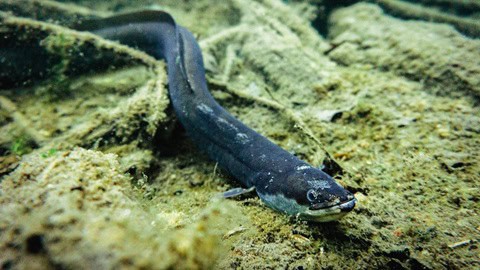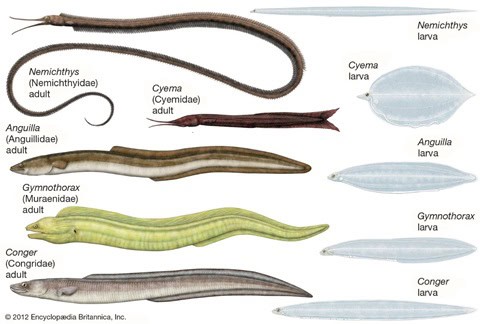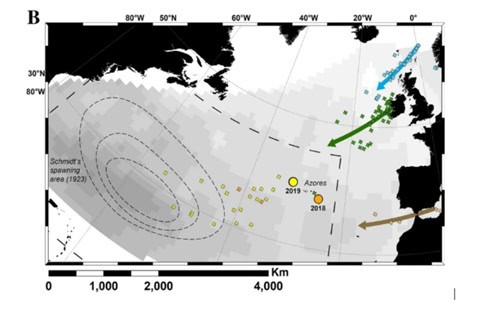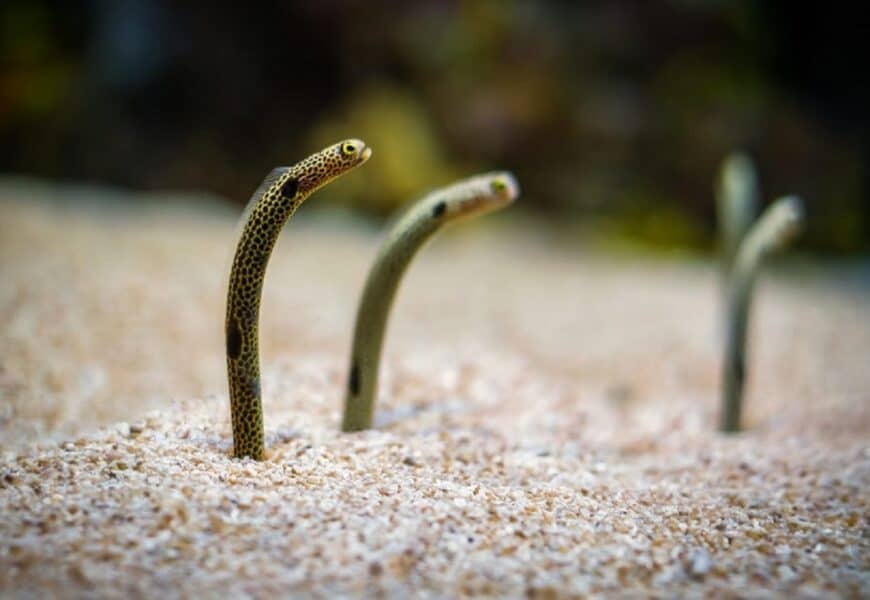Anguillid eels have troubled ecologists and environmentalists for centuries. From the ancient Greeks, who believed eels were born spontaneously from mud, to Pliny the Elder, who described them as emerging from the earth itself, and Aristotle, who was perplexed by their lack of reproductive organs, the eel has slipped through the grasp of understanding. These slippery fishes have been consumed, revered, and even used as fertilizers, yet they remain one of the most enigmatic creatures in the aquatic world.
Table of Contents
Toggle- How is it that such a common character of the natural world inspires such a head-scratching discussion?
- What exactly is it about them that has been puzzling us for so long?
- Where do they come from?
- How do they reproduce?
As a wannabe marine ecologist myself, eels have fascinated me since I first learned of their complex lifestyle. Here’s my disposition on these mysterious creatures.

What are Eels?
Classification of Eels
To begin unraveling the mystery of eels, we first need to understand what they are. Eels belong to the order Anguilliformes, a group of ray-finned fish known for their elongated bodies and snake-like appearance. However, to the innocence of the spoken word, the term “eel” is somewhat ambiguous, as it is also applied to several eel-like clades that have evolved their similar shapes independently. For example, the electric eel (genus Electrophorus) and swamp eels (order Synbranchiformes) are often referred to as eels, despite belonging to different evolutionary branches.

Habitat
Most eels are marine creatures, thriving in the depths of the ocean. However, there are exceptions, such as the catadromous European eel (Anguilla anguilla), which spends most of its life in freshwater before returning to the sea to spawn. Additionally, some species like the anadromous rice-paddy eel spawn in freshwater but spend their adult lives in marine ecosystems. This complex and varied lifestyle is part of what makes studying eels so challenging—and so intriguing.
The Enigma of Eel Reproduction
The Greeks
One of the most perplexing aspects of the eel’s life is its reproduction. The Greek philosopher Aristotle, who laid much of the foundation for early biological thought, was baffled by them. He observed that eels lacked any visible reproductive organs, leading him to speculate that they emerged spontaneously from mud and decaying plant matter—a theory that, while incorrect, was accepted for centuries.
Pliny the Elder and the Romans
Similarly, the Roman naturalist Pliny the Elder wrote in his Natural History that eels were born from fragments of skin shed by their parents, or from the mud of riverbanks—ideas that reflect the mysterious and almost magical status they held in the ancient world. These early attempts to understand them illustrate just how elusive these creatures have been throughout history.
Contemporary Attempts
Even with the advent of more modern scientific methods, the mystery continued. In 1777, the Italian anatomist and physician Carlo Mondini dissected and located an eel’s ovaries, establishing that it is a fish. Even the father of psychoanalysis himself, Sigmund Freud, was obsessed with this mystery as he cut out hundreds of male eels to locate its reproductive organs. It wasn’t until the 19th century that researchers discovered that eels develop their reproductive organs only after beginning their migration back to the sea. This late-stage development and subsequent disappearance of these organs after spawning left scientists with few clues about their reproductive processes. Theories abound—do they reproduce in the mysterious depths of the Sargasso Sea, where they’re believed to migrate? Or is there another, even more elusive explanation? The truth remains as slippery as the eels themselves.
Life Cycle
Larval Stage
The life cycle of the catadromous European eel (Anguilla anguilla) is a journey that spans thousands of miles and several distinct stages. Starting as flat, translucent larvae known as leptocephali, these eels drift through the oceans’ surface waters, feeding on marine snow—tiny particles of organic detritus that float down from the ocean’s upper layers. This stage can last up to three years, during which time the larvae are carried by ocean currents across vast distances.
Juveniles
When the leptocephali reach the continental shelf, they undergo a remarkable transformation into glass eels, small and transparent, ready to embark on the next stage of their journey. It’s here, as they enter inland waters, that eels undergo another dramatic change, developing ray-like fins and morphing into elvers, the juvenile stage of their development. As they swim upstream into rivers and streams, they become yellow eels, the adult stage where they’ll spend the majority of their lives, feeding and growing.
Adults
The final stage of their life cycle is no less astonishing. These eels, now fully grown and known as silver eels, will undertake a perilous journey back to the ocean to spawn. The exact location remains one of nature’s best-kept secrets, but many believe it occurs in the depths of the Sargasso Sea, a remote and mysterious area in the North Atlantic. It was the Danish biologist Johannes Schmidt who, in the early 20th century, first hypothesized that the Sargasso Sea might be the spawning ground of the European eel. His research, based on the location of the smallest eel larvae, provided a crucial clue, yet to this day, no one has directly observed eels spawning in the wild.

Sargasso Sea as The Natural Nursery
Even after establishing and conclusively convincing the scientific community of the Sargasso Sea being the initial nursery ground for the European eel, no one had actually seen an eel in the Sargasso Sea, until 2022.
Dr. Rosalind M. Wright and her team tagged 26 individuals from the Azores archipelago and provided the first ever direct evidence of an adult European eel entering the Sargasso Sea.
This phenomenal breakthrough did all, but also gave way to another mystery. The time period of the them leaving the Azores and reaching the Sargasso Sea is between 1 and 6 months to reach the Sargasso Sea before the end of the expected spawning period. But none of the tagged individuals in the study were fast enough to complete their journey to reach the Sargasso Sea during the spawning season.

Evolving Perception about Eels
The perception of eels has evolved significantly over time. From the mythical origins suggested by Aristotle and Pliny to the scientific inquiries of the modern era, our understanding of eels has expanded, yet many questions remain. The mysterious migration to the Sargasso Sea and the elusive nature of their reproduction continue to captivate scientists and enthusiasts alike. Today, the eel stands as a symbol of the unknown, a reminder of how much there is still to discover in the natural world.
Conclusion
The mystery of the eel remains a tantalizing puzzle, one that has captivated humanity for generations. As we continue to study these elusive creatures, perhaps one day we’ll unlock the secrets of their reproduction, migration, and more. Until then, the eel’s story is a reminder of how much there is still to learn about the natural world. What other secrets might the oceans hold, waiting for a curious mind to discover?
References
- Wright, R.M., Piper, A.T., Aarestrup, K. et al. First direct evidence of adult European eels migrating to their breeding place in the Sargasso Sea. Sci Rep 12, 15362 (2022). https://doi.org/10.1038/s41598-022-19248-8
- Eel by Richard Schweid
- https://biblioscout.net/book/10.25162/9783515116701#page=110
- Verhelst, P., Reubens, J., Coeck, J. et al. Mapping silver eel migration routes in the North Sea. Sci Rep 12, 318 (2022). https://doi.org/10.1038/s41598-021-04052-7
- https://www.smithsonianmag.com/science-nature/the-utterly-engrossing-search-for-the-origin-of-eels-180980777/
For more intriguing insights into other STEM-related topics, visit ENTECH Online. Check out our digital magazine. It aims to inspire teenagers and young adults. We want them to follow their interests in science, technology, engineering, and mathematics.
FAQs
1. What makes eels so mysterious?
Eels have puzzled scientists for centuries. Their reproductive behavior is elusive. They have a complex life cycle. People once thought they emerged spontaneously from mud. Scientists recently confirmed they migrate to the Sargasso Sea to spawn. This migration is particularly mysterious. Many aspects of eel reproduction are still unknown.
2. How did ancient civilizations perceive eels?
The ancient Greeks, including Aristotle, thought eels were born spontaneously from mud. The Romans, like Pliny the Elder, believed they emerged from the earth or from pieces of their skin. These early ideas show how hard it was to understand their biology because they don’t have visible reproductive organs.
3. What is the Sargasso Sea, and why is it important to eels?
The Sargasso Sea, located in the North Atlantic, is believed to be the spawning ground for European eels. Despite this hypothesis, direct evidence of them spawning there has only been observed recently. The sea’s role as a nursery for eel larvae makes it a critical area for studying these creatures.
4. How do eels reproduce, and why is it so difficult to study?
Eels develop their reproductive organs only when they migrate back to the sea. After they spawn, their reproductive organs disappear. This late development happens very late in their lives. They spawn in deep and remote locations. These factors make it challenging for scientists to observe and understand their reproductive processes.
5. What stages are involved in the life cycle of a European eel?
The life cycle of a European eel includes several stages:
– Leptocephali: Flat, translucent larvae that drift in ocean currents.
– Glass Eels: Small, transparent juveniles that migrate to coastal waters.
– Elvers: Juveniles that develop ray-like fins and enter freshwater.
– Yellow Eels: Adult stage where they live in freshwater, feeding and growing.
– Silver Eels: Fully grown adults that migrate back to the sea to spawn.
6. Why is the eel’s migration back to the sea so significant?
The migration of eels back to the sea is amazing and not well understood. They travel to the Sargasso Sea, a part of the Atlantic Ocean, for this journey. This trip is important. During the journey, they spawn, which means they lay eggs. This ensures their species continues. However, many details of this process are still a mystery.
7. What recent discoveries have been made about eel migration?
In 2022, Dr. Rosalind M. Wright and her team showed that adult European Eels enter the Sargasso Sea. This was the first direct evidence of such behavior. However, the timing of their journey brought up new questions. They did not reach the sea during the expected spawning season. This unexpected timing suggests there is more to learn about their migration and reproductive behavior.
8. Why are eels important to study?
Studying eels is important to understand their unique biology. It’s also important to protect them. They are fishes that live in both marine (ocean) and freshwater (rivers and lakes) ecosystems. They transport essential nutrients from deep ocean waters to rivers and lakes on the mainland. This process helps maintain healthy ecosystems.
Many of their species are now endangered. To save them, we need to understand their life cycle and migration patterns. Learning about them also shows us how much we still don’t know about nature. This inspires curiosity and encourages more research.
SEE ALSO:














A fascinating dive into the mysterious life of eels, blending history and science seamlessly. The article unravels complex topics with clarity, making it a captivating read for anyone curious about these elusive creatures.